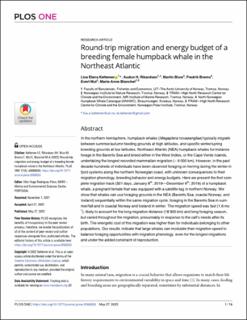| dc.description.abstract | In the northern hemisphere, humpback whales (Megaptera novaeangliae) typically migrate between summer/autumn feeding grounds at high latitudes, and specific winter/spring breeding grounds at low latitudes. Northeast Atlantic (NEA) humpback whales for instance forage in the Barents Sea and breed either in the West Indies, or the Cape Verde Islands, undertaking the longest recorded mammalian migration (~ 9 000 km). However, in the past decade hundreds of individuals have been observed foraging on herring during the winter in fjord systems along the northern Norwegian coast, with unknown consequences to their migration phenology, breeding behavior and energy budgets. Here we present the first complete migration track (321 days, January 8th, 2019—December 6th, 2019) of a humpback whale, a pregnant female that was equipped with a satellite tag in northern Norway. We show that whales can use foraging grounds in the NEA (Barents Sea, coastal Norway, and Iceland) sequentially within the same migration cycle, foraging in the Barents Sea in summer/fall and in coastal Norway and Iceland in winter. The migration speed was fast (1.6 ms-1), likely to account for the long migration distance (18 300 km) and long foraging season, but varied throughout the migration, presumably in response to the calf’s needs after its birth. The energetic cost of this migration was higher than for individuals belonging to other populations. Our results indicate that large whales can modulate their migration speed to balance foraging opportunities with migration phenology, even for the longest migrations and under the added constraint of reproduction. | en_US |
